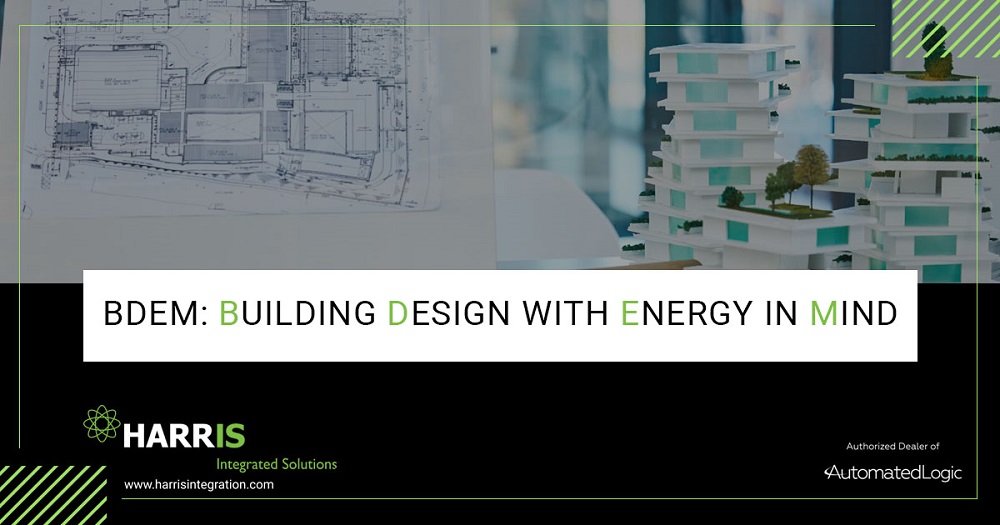
BDEM: Building Design with Energy in Mind
When planning the construction of a new building, energy efficiency should be at the forefront of the design concept. Taking the time to build with energy efficiency in mind may incur additional costs on the front end, but doing so could significantly reduce long-term operational costs and provide greater financial benefits to the owner in the years to come. For this reason, it is important to consider consulting an energy specialist to guide the design process.
Designing buildings for energy efficiency can result in cost savings for the building’s owner over time. To ensure that energy savings are maximized, the initial planning stage should employ BDEM (Building Design with Energy in Mind). This strategy does not need to be costly or extravagant. There are proven, cost effective technologies and strategies that can help reduce energy use without relying on unproven or expensive products. Consider the following techniques to create an energy efficient building that saves thousands of dollars in energy costs.
The Power of Place: The Importance of Location in BDEM
According to the International Energy Conservation Code 2021, North and South Carolina are classified as being in Zone 3A Warm Humid, meaning that more energy will be consumed for cooling than for heating. Designers must take this into consideration when constructing buildings in this region. To optimize energy efficiency, buildings should be designed to limit direct sunlight exposure from the east and west, and to take advantage of the sun’s path by orienting the building or additional features such as solar panels towards the sun.
The benefits of trees on energy use cannot be overstated. Properly managed tree removal and planting can save building owners thousands of dollars in cooling costs. Shading buildings with trees on the west side helps mitigate the hot afternoon sun, while additional trees can produce an oxygen-rich environment and reduce the need for mechanical cooling. Careful planning and consideration is required to achieve these energy savings while preserving the maintenance and landscape of the building.
Staying Cool and Saving Energy: HVAC Systems in BDEM
When deciding on an HVAC system, it is important to weigh the pros and cons of using a centralized plant versus individual DX Direct Expansion (traditional heat pump/ac) equipment. Each option has benefits and challenges that must be taken into consideration when making a decision.
While centralized plants generally demand a higher investment and necessitate key personnel for maintenance due to the need for specialized parts and extensive training, they offer notable advantages. Their efficiency in large spaces surpasses traditional heat pumps, and they have a longer service life. Furthermore, the design allows for easier concealment which contributes to a more appealing aesthetic. For perspective, a single 100-ton chiller efficiently fulfills the role of 20 separate 5-ton air conditioners, resulting in less architectural intrusion and structural support requirement.
On the other hand, DX equipment continues to be the most popular choice in the market. The readily available parts and service technicians’ familiarity with DX equipment repairs make it an attractive option. It provides the added advantage of targeted cooling for unoccupied spaces. For instance, if an office needs cooling beyond regular working hours, there’s no need for a high-capacity 100-ton chiller; the DX unit designated for that area will be used.
Illuminating Efficiency: Electrical Systems in BDEM
The efficiency of electrical systems is paramount. In the past, electrical engineers often designed their buildings with an overabundance of power. Large transformers would hum, producing heat enough to rival an iceberg’s melting point. This process resulted in energy losses during voltage conversions. It’s crucial to remember that each degree of heat a transformer emits corresponds to a loss of power, which translates to cost. When you consider this happening around the clock, the expenses can accumulate substantially.
However, the technologies of today far surpass those of years ago. Modern smart transformers can balance loads, significantly reducing energy losses during the transformer stage. Smart breakers can display amp draw and can be integrated into building automation systems for remote control, allowing them to be turned off when not in use. As for LED lighting, it’s prudent to choose products from established and reliable companies. A 5-year or 10-year warranty won’t serve any purpose if the company ceases to exist, so it’s vital to choose wisely.
The Cornerstone of Control: The Role of a Superior Building Automation System in BDEM
There is a wealth of proven BDEM technologies such as:
- Solar Panels
- Tankless water heaters
- Windows
- Roofing material
However, it is crucial to remember one primary BDEM strategy – if you cannot control your building, you won’t be able to control your energy consumption! This is precisely where a Building Automation System (BAS) steps in. But remember, your BAS needs to be more than just good; it needs to be the perfect fit. It should be reliable, easy to navigate, and adaptable enough to manage the building’s components effectively. Additionally, it should come with a strong support system to guarantee smooth operation long after the installer has packed up and left. This support should include regular recommissioning and potentially include service agreements. Also, considering cloud hosting for software updates could be a practical alternative.
For monitoring energy consumption, the installation of energy or power meters is necessary. These can facilitate scheduling or designed load shedding to conserve energy while maintaining comfort levels. The system must be secure from cyber threats, yet readily accessible to operators when needed.
The Department of Energy states that South Carolina consumes over twice as much energy as it produces. Given this dependency on out-of-state energy, BDEM can play a significant role in reducing this gap and help owners reduce operating costs in the long run.
Tony Holcomb is an Energy Consultant with Harris Integrated Solutions. He is retired Director of Maintenance and Operation for Georgetown County Schools in South Carolina. He served three years as Vice Chairman for the Association of South Carolina Energy Managers, won South Carolina Energy Manager of the Year in 2016, and won South Carolina Energy Project of the Year in 2013. To Holcomb, his biggest career accomplishment was not having to increase Georgetown County School District’s energy budget over 14 years, helping keep teachers employed and students learning.







